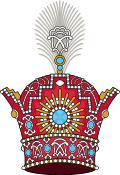Shāhanshāh
 |
|
|
Emperor: Padishah, Shahanshah
|
|
|
High King
|
|
|
King: Sultan, Malik, Shah, Khan
|
|
| Royal Prince : Shahzada (Şehzade), Mirza | |
| Noble Prince : Sahibzada | |
| Nobleman: Nawab, Baig, Begzada | |
| Royal house : Damat | |
| Governmental : Lala, Agha, Hazinedar |
Shah (/ˈʃɑː/; Persian: شاه, translit. Šāh, pronounced [ʃɒːh], "king") is a title given to the emperors, kings, princes and lords of Iran (historically also known as Persia). It was also adopted by the kings of Shirvan (a historical Iranian region in Transcaucasia) namely the Shirvanshahs, the rulers and offspring of the Ottoman Empire (in that context spelled as Şeh), Mughal emperors of the Indian Subcontinent, the Bengal Sultanate, as well as in Afghanistan. In Iran (Persia and Greater Persia) the title was continuously used; rather than King in the European sense, each Persian ruler regarded himself as the Šāhanšāh (King of Kings) or Emperor of the Persian Empire.
The word descends from Old Persian xšāyaθiya "king", which (for reasons of historical phonology) must be a borrowing from Median, and is derived from the same root as Avestan xšaϑra-, "power" and "command", corresponding to Sanskrit (Old Indic) kṣatra- (same meaning), from which kṣatriya-, "warrior", is derived. The full, Old Persian title of the Achaemenid rulers of the First Persian Empire was Xšāyathiya Xšāyathiyānām or Šāhe Šāhān, "King of Kings" or "Emperor". This word is commonly confused with the unrelated and distinct Indian surname Shah, which is derived from the Sanskrit Sadhu or Sahu, meaning "gentleman".
...
Wikipedia
